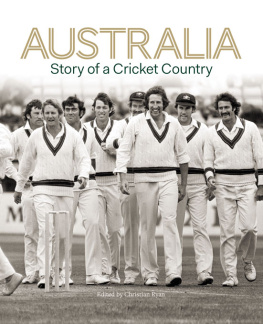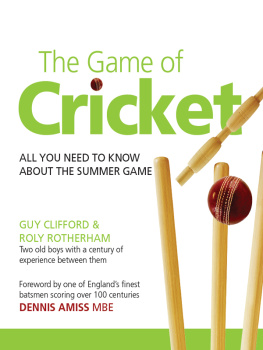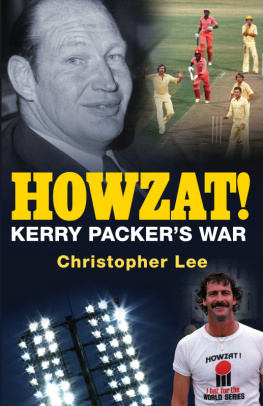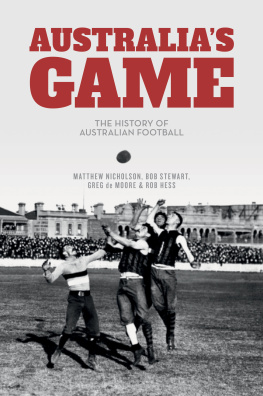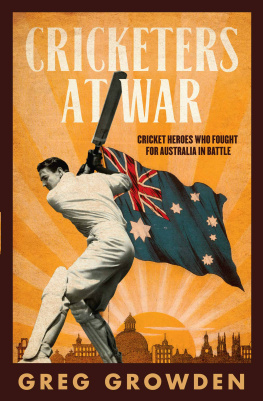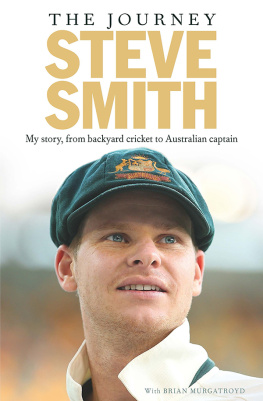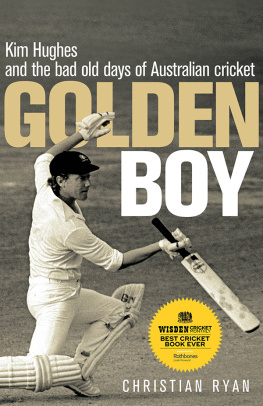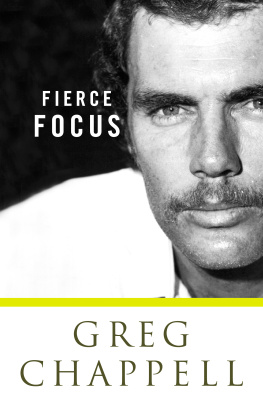
AUSTRALIA
Published in 2011 by Hardie Grant Books
Hardie Grant Books (Australia)
Ground Floor, Building 1
658 Church Street
Richmond, Victoria 3121
www.hardiegrant.com.au
Hardie Grant Books (UK)
Dudley House, North Suite
3435 Southampton Street
London WC2E 7HF
www.hardiegrant.co.uk
All rights reserved. No part of this publication may be reproduced, stored in a retrieval system or transmitted in any form by any means, electronic, mechanical, photocopying, recording or otherwise, without the prior written permission of the publishers and copyright holders.
The moral rights of the author have been asserted.
2011 Copyright in the text is retained by the individual authors.
2011 Copyright in the photography is retained by the individual rights holders (see picture credits).
National Library of Australia Cataloguing-in-Publication Data:
Ryan, Christian.
Australia : story of a cricket country / Christian Ryan.
EISBN 9781742736952
CricketAustraliaHistory.
CricketAustraliaSocial aspects.
796.3580994
Design and layout by Hofstede Design
Cover image courtesy of Patrick Eagar
Body text set in Freight Text 9.5/12pt
Typefaces used are Freight Text, Fakt and AW Conqueror Inline
Colour reproduction by Splitting Image Colour Studio
Every effort has been made to incorporate correct information and to attribute copyright. The publishers regret any errors or omissions and invite readers to contribute up-to-date or additional relevant information to Hardie Grant Books.

Contents
NOT MANY OF THE BATSMEN in the pictures in this book have helmets on.
Two summers ago I went to a cricket ground because Id seen it on a map and liked the name, Hays Paddock, and when I got there not only were both batsmen wearing helmets, the wicketkeeper was too, and this was a twenty-one-overs-a-side boys game, with the ball being propelled at boys pace and going through at boys height. I know this because I took notes. Boroondara were batting and balls in the second, sixth, ninth, eleventh and fourteenth overs got up bellybutton-high. Three further balls went within range of batsmens ribs, breastbones and necks. Not much prospect that heads might roll. I saw the fidgety wicketkeeper take off his helmet after one over and carry it under his arm to the other end. The late afternoon was hot; he must have been dripping beneath that tin. Then he put the helmet back on. And he stood: half a pitch-length back from the pitch itself, where a fast bowler bowled.
You can still get out in a helmet. But theres little chance youll get frighteningly, horribly hurt. The two worries that used to live in a batsmans mind are now one.
You cant see peoples faces when they are wearing helmets.
Some say these are trivial points. But theyre everything. Give me worry, and faces: give me Trott sneering, Gregory chirping, Macartney puffing, Redpath wincing, Toohey bleeding, Hughes imping, Lehmann melting.
David Frith once put out a mammoth, joyous book of pictures and captions, Pageant of Cricket, and in it he wrote this: A stage for art and drama, chicanery and vaudeville humour, and for endlessly unexpected happenings, cricket is revered by millions, and will last in some shape or form forever.
It is a sentence I did not know till I read it just then. Now I cant stop reading it. I know I should find this sentence comforting. Instead it fills me with blackness. How could Frith have been so wrong so fast? He wrote that sentence in 1987.
And I just heard on the radio a violinist say he used to practise the violin while watching cricket on TV because the games gaps and quietudes let him drift in and out of subconsciousness.
And I just read on a blog that another city bookshop is closing.
And it strikes me that out of the games many variations, Test cricket and one-day cricket and Twenty20, and then adding on top of these French cricket, backyard cricket, Kanga Cricket, Continuous Cricket, Kwik Cricket, indoor cricket and Milo Have-A-Go cricket, only one doesnt have cricket in the name.
And I just tried looking up this coming summers itineraryand they say theyre still working it outbut theres to be a two-Test series and a four-Test series and no five-Test series, and I dont see any Lilac Hill match, and theres talk the Shield final is on its last legs, while in the much bigger Big Bash the Strikers will be hosting the Renegades in Adelaide where soon therell be a portable drop-in strip instead of a cricket pitch.
That sentence of Friths makes me think of a 1956 paragraph of E.B. Whites, a fragment of which goes:
Dr Fritz Zwicky, the astrophysicist, has examined the confused situation on this planet, and his suggestion is that we create one hundred new planets. Zwicky wants to scoop up portions of Neptune, Saturn and Jupiter and graft them onto smaller planets, then change the orbits of these enlarged bodies to make their course around the sun roughly comparable to that of our earth. This is a bold, plucky move, but I would prefer to wait until the inhabitants of this planet have learned to live in political units that are not secret societies and until the pens on the writing desks in banks are not chained to the counter.
Unlike Frith, E.B. White knew what was coming. He knew that what was coming was already on the doorstep. Still, he had hope inside. Thats how I feel about cricket now. Its how I feel about this book: it is a celebration of the game as it was, isnt, but could be again.
Christian Ryan,
July 2011
Michael Hussey throws to the keepers end, SCG, January 2009.
A girl skulks along memorys edge
T here is a lot of talk these days about childhood memories being the fountain from which we replenish our unique but depleting adult selves. This generates even more talk about the reliability of memories. What follows is constructed out of irreplaceable, indispensable, unreliable memories, the only corrections being those insisted on by my brother David Jewell, who played for Newtown and Chilwell Cricket Club (Senior Matting) over many years.
Remembered: a cricket ground at Queens Park, Geelong. A beautiful ground ringed by a white line to mark the boundary, a white fence for leaning on, and an outer ring of storm-green pines. The sun is high at 2 p.m. when the game begins; the shadows lengthening, the sounds of bat and ball more distant as the sun slants and the game moves to its close at six. For me the cricket is always sunlit, perhaps because on wet or blustery or blistering days I find something else to do. The players in their creams and streaked white boots lounge on matted pine needles or in the natural armchairs of pine roots polished by years of exposure and a couple of generations of human bottoms. Someonethe one-legged opener?is sitting, rather grandly, on a deck chair; beyond him, Captain Morrys 1932 Chevy. Its handsome red grille noses the fence. A shadowy someone is in the passenger seat: Mrs Morry? No other women. Wives are present only in the gleaming cream of cricket shirts and pants. And I have my first puzzle: how was my recalcitrant mother persuaded to fuss over cricketing creams in the clatter and steam of her huge Monday boil-ups? My brother tells me that afternoon tea used to be served by the home-team ladies during the twenty-minute break, but now, at the close of the war, there is no afternoon tea and minimal fraternising with the opposition: they have their own strip of boundary, their own pine trees, their own little cluster of spectators. In our cluster theres some moments of clapping, some peaceable ribbingto a player back after the second ball has spread his stumps, Couldnt bear to leave us, Charlie?but mainly we watch in silence, and when it is over everyone goes home for the meal we call tea. My family eats at six, but on cricket nights my mother has the meal on the kitchen table at 6.30 sharp. Talk and analysis, if they happen, happen elsewhere.
Next page
